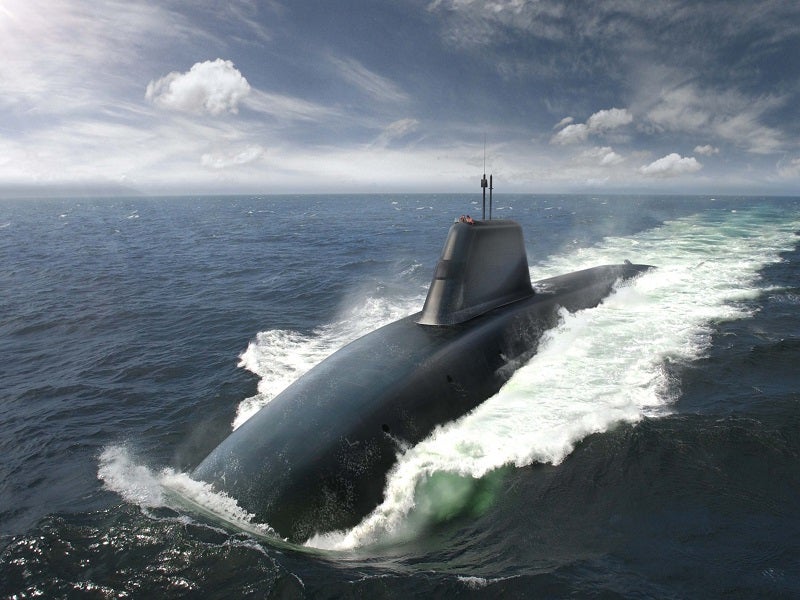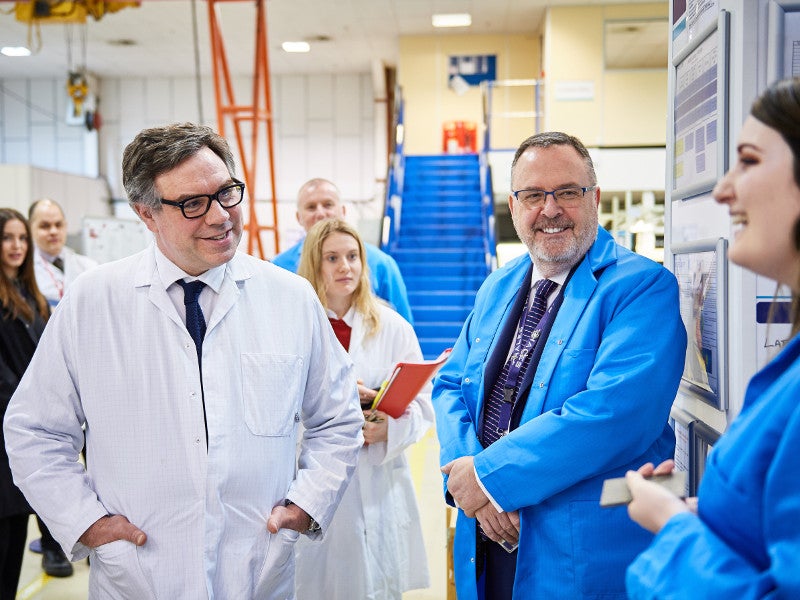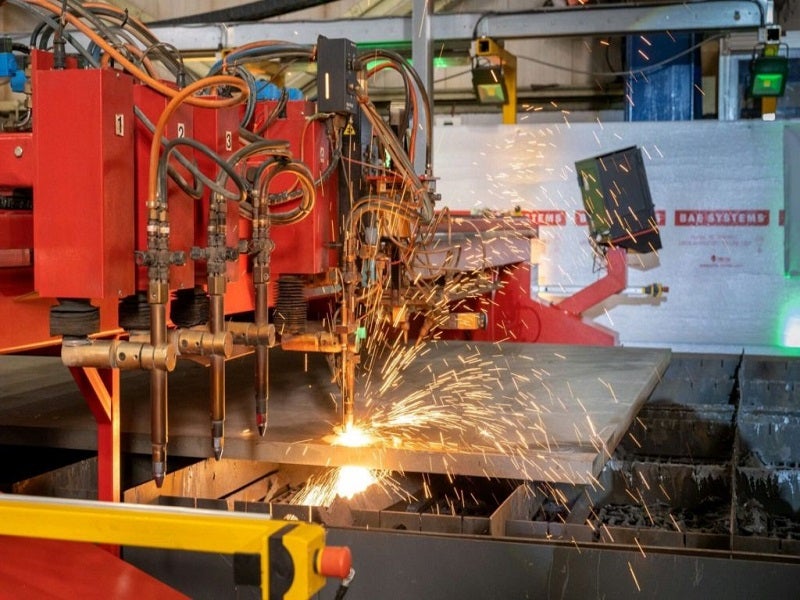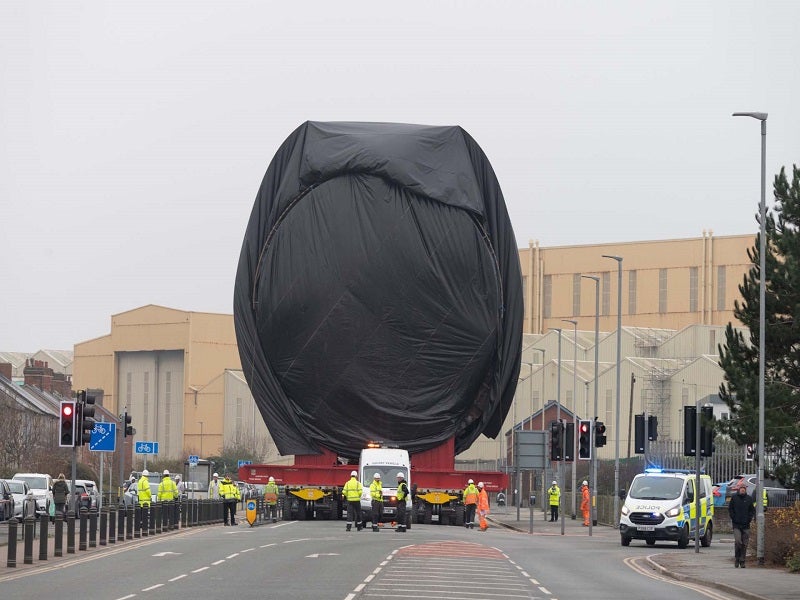Dreadnought-class nuclear-armed ballistic missile submarines are being constructed by BAE Systems at its Barrow-in-Furness shipyard in Cumbria, UK, for the Royal Navy.
The UK Government is supporting the Dreadnought ship, submersible, ballistic, nuclear (SSBN) programme, which involves the construction of four Dreadnought submarines. The four SSBNs are named HMS Dreadnought, HMS Valiant, HMS Warspite and HMS King George VI.
The Trident missile-armed Vanguard submarines will soon reach the end of their lifespan. The Dreadnought-class submarines will replace the four existing Vanguard-class SSBNs to maintain continuous at-sea deterrence (CASD).
The total estimated cost for the Dreadnought programme is approximately £31bn ($47.07bn). The first submarine is expected to enter service in the 2030s with a service life of a minimum of 30 years.
The programme achieved a new milestone with the start of construction of the third submarine, HMS Warspite, in February 2023.
Dreadnought-class submarine programme details
The Dreadnought programme is based on a white paper published by the UK Ministry of Defence (MoD) in December 2006. The document concluded that the construction of a new class of ballistic missile submarines is the most effective option for achieving and maintaining a nuclear deterrent capability. The parliament backed the white paper conclusions in March 2007.
The MoD then conducted a concept analysis and the assessment phase of the programme. It provided £201m ($291.4m) funding to BAE Systems for the development of the submarine design, including the layout of equipment and systems and manufacturing processes in February 2016. The company was previously awarded two funding packages in 2012 to start the initial design and another in 2015 to work on the detailed design.
In July 2016, the House of Commons approved the construction of four Dreadnought-class submarines over the next 15-20 years, enabling the programme to transition to the manufacturing phase. The first metal-cutting for the programme was conducted in October 2016 after the UK Government announced funding of £1.3bn ($1.68bn).
The programme received additional funding of £960m ($1.29bn) from the MoD in May 2018. The Defence Secretary provided £400m ($503.1m) in funding for the programme in December 2018.
A new alliance was formed in April 2018 for delivering the Dreadnought programme. Known as the Dreadnought Alliance, the partnership between the government and industry includes the MoD’s Submarine Delivery Agency (SDA), BAE Systems and Rolls-Royce.
SDA’s role in the alliance covers the supply of equipment for the strategic weapon system of the submarines. BAE Systems is the designer and shipbuilder, while Rolls-Royce is responsible for designing and manufacturing a nuclear propulsion system.
The contracts for the second phase of the build programme, known as delivery phase 2 (DP2), were signed in May 2018. DP2 involved the continuation of the construction of HMS Dreadnought and the start of the construction of the second submarine in the class.
The MoD announced contracts worth more than £2bn ($2.46bn) for delivery phase 3 (DP3) in May 2022. The contracts were awarded to BAE Systems and Rolls-Royce to commence DP3, which represents the most significant phase of the programme so far. The overall investment in DP3 is estimated to be £10bn ($12.32bn). DP3 will include sea trials of HMS Dreadnought.
Construction details
The first three Dreadnought-class submarines are currently under construction. Construction of HMS Dreadnought began at BAE Systems’ shipyard in Barrow-in-Furness, Cumbria, in October 2016.
The keel for Valiant was laid in 2019. The steel-cutting ceremony for Warspite was held at the Barrow-in-Furness site in February 2023.
Dreadnought-class submarine design and features
Upon completion, the Dreadnought-class submarine will become the Royal Navy’s largest submarine. It will have a length of 153.6m and displacement of 17,200t. It will be installed with 42.5km-long piping, approximately 13,000 electrical items and more than 20,000 cables.
The submarine will be manned by 130 crew members, including three chefs and a doctor. A designated sickbay will allow the doctor to conduct routine check-ups and distribute medicines.
The submarine will also have separate crew accommodation, toilets and washing facilities for female personnel. A separate study area will be built and gym facilities, including exercise bikes, rowers and weight benches, will also be available.
The vessel will be capable of producing its own oxygen and fresh water. It will feature innovative lighting, simulating day and night.
A new design will be incorporated to make the submarine technologically advanced and safe.
The Dreadnought submarines are being built in 16 blocks, which will be grouped into three major units, including aft, mid and forward.
Each ship will be equipped with the latest Sonar 2076 system, which will provide the vessel with advanced acoustic detection capability.
The sonar, currently in operation with Astute-class submarines, has a combination of outboard arrays and an inboard processing capacity. The sonars and sensors will increase the crew’s visual and situational awareness.
In addition, the vessels will have a combat system mast that will integrate optical systems, electronic warfare and communications.
Weapons aboard Dreadnought-class submarines
The Dreadnought-class submarine will be installed with eight operational missile tubes for launching Trident II D5 missile that can carry nuclear warheads. Four additional tubes will be configured with ballast.
The Trident ballistic missile is a solid-fuel, inertial-guided missile that can carry multiple W76-Mk4/Mk4A or W88-Mk5 re-entry bodies. It has an operational range of 4,000nm (7,360km).
The UK is developing a common missile compartment (CMC) that will accommodate the Trident weapons system, in co-operation with the US. The two countries are involved in a programme to extend the Trident II D5 missile’s service life until the early 2060s. The UK is also considering options for the replacement of the existing nuclear warhead, which is expected to be in service until the early 2040s.
Fly-by-wire technology
BAE Systems started work on adapting fly-by-wire technology for the programme in March 2021. The complete active vehicle control management (AVCM) system, which employs technology similar to the one used in fly-by-wire aircraft, will control heading, depth, pitch, buoyancy, and other aspects of the Dreadnought-class submarines.
Propulsion
The submarine will be powered by Rolls-Royce nuclear propulsion system known as Pressurised Water Reactor 3 (PWR3). The MoD considered three PWR options, including PWR2, PWR2b, and PWR3. The PWR3 propulsion system incorporates a new design and leverages technology to deliver benefits such as simplified operations, longer service life and reduced maintenance costs over the lifecycle.
PWR3 delivers better performance when compared to the other two options and will help reduce maintenance periods and improve availability. The vessel will be equipped with advanced reactor cores, enabling them to operate for 20 years without the need for refuelling.
Contractors involved
Charles Stark Draper Laboratory, an engineering innovation company based in the US, received a $109.5m contract modification to perform research into technologies to meet guidance requirements for CMC in November 2018. The company was engaged to provide technical support for the hypersonic guidance, navigation and control applications to be used in hypersonic flight experiments for the Trident II ballistic missiles for the Columbia-class and Dreadnought-class submarine programmes.
Thales received a £330m ($425.6m) contract from BAE Systems Submarines to provide Sonar 2076 system and combat system mast for the four Dreadnought-class submarines, in February 2020. The contract will create or maintain 520 jobs in manufacturing, engineering and design sectors at Thales’ UK locations, including Templecombe, Cheadle Heath, Crawley and Glasgow.
General Dynamics Mission Systems received a contract in December 2019 to continue modernisation and sustainment work related to fire control systems and subsystems aboard SSBNs of the US Navy and the Royal Navy. The contract scope also included the development of a fire control system for the Dreadnought-class submarines and the US Navy’s Columbia-class submarines.
General Dynamics Mission Systems was contracted for the development, production, installation, and support for the fire control system of the Columbia-class and Dreadnaught-class ships in June 2020.
The company also received a six-year contract worth $272.9m for the development, production and installation of fire control systems for the Columbia-class and Dreadnaught-class submarines, in July 2022. The contractual scope includes the development and production of fire control systems for the third Dreadnought-class submarine and the second and third Columbia-class submarines.
The company is also responsible for providing support to upgrades for the strategic weapons systems onboard the strategic ballistic missile submarines currently in service with the Royal Navy and the US Navy.
General Dynamics Electric Boat, a subsidiary of General Dynamics, received two contract modifications to continue the development of CMC for the future nuclear submarine programmes of the US and the UK, in August 2011.
It received a $55m contract modification to manufacture 18 missile tubes for the Dreadnought-class and Columbia-class submarines in April 2020. The contract was awarded under the joint CMC programme between the US and the UK.
Babcock International Group was contracted by General Dynamics Electric Boat to produce 22 tactical missile tube assemblies for the CMC project in October 2016.
Lockheed Martin Space, a business division of Lockheed Martin, was appointed to support the integration of the Trident II D5 missile and re-entry components into the CMC for the Dreadnought-class and Columbia-class submarines, in March 2021.
Northrop Grumman, a multi-national aerospace and defence company based in the US, is responsible for the production of launcher subsystem hardware as part of the CMC programme. The company received a contract worth $458m to support the Columbia-class and Dreadnought-class submarines in June 2022. The contractual scope includes programme management, shipyard field operations, hardware production work, systems engineering, documentation, and logistics.
Raytheon UK was engaged as the prime contractor and systems integrator for the crew training programme for the Dreadnought project in May 2022.
The company will provide an integrated training solution that will be integrated into the new Future Submarine School (FSS) at Her Majesty’s Naval Base Clyde and other training facilities of the Royal Navy. The solution will be used to train all future crew members of the new Dreadnought-class submarines.
Raytheon UK will be supported by Vertex Professional Services, Frazer-Nash Consultancy, and Elbit Systems UK. At the end of the seven-year contract period, Raytheon UK will hand over the day-to-day responsibilities of the crew training scheme to the Fisher Training consortium, which is led by Capita, a consultancy and digital services business. The consortium, which also comprises Raytheon UK, Elbit Systems UK, and Fujitsu, was awarded a 12-year contract to provide shore-based training to the Royal Navy and the Royal Marines across 16 sites in the UK in December 2020.











